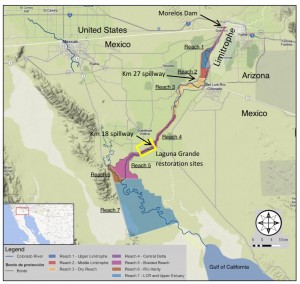The International Boundary and Water Commission today released its initial science report (pdf) on this spring’s Colorado River pulse flow. A few key bits:
- When you add water, stuff grows. Satellite imagery in June ’14 compared to a year earlier showed a 36 percent increase in the Normalized Difference Vegetation Index. The NDVI increased in all but one area (the area where vegetation was cleared to prepare for flooding and new plant germination, which makes sense).
- Cottonwoods liked it. Tamarisks loved it. In the 4,522 acres of channel and flood plain inundated by surface water, cottonwoods seedlings seemed to take hold in the “Reach 1” and “Reach 4” sections of the pulse flow area (see map). Non-native tamarisk did well everywhere. What happens next depends on the availability of soil moisture fed by groundwater. More study, more time needed.
- Birds seem to be liking the habitat restoration areas. That also makes sense. I’d like them if I were a bird.
- The water table rose, but the rise was really focused in the river channel area between the levees.
A digression that’s important: When I was giving a talk about the pulse flow this fall, a cranky member of the audience took issue with my enthusiasm for all this, pointing to Aldo Leopold’s “green lagoons”, the two million acres that used to be the delta. This was 4,522 acres. As we discuss and describe this very promising experiment at the interface of water management and environmental restoration, it’s important to keep the scales in mind.

